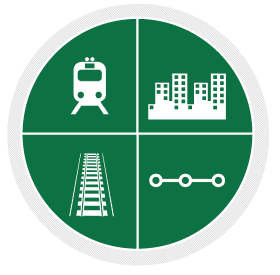
The FRA designed the NEC FUTURE alternatives development process to consider a broad array of future possibilities for the NEC, ranging from the status quo to transformational changes in the way passenger rail service is provided. This sequential process began with the development of approximately 100 Initial Alternatives informed by the scoping process, which were then organized into 15 Preliminary Alternatives that represent the broad spectrum of possible approaches to serving existing and new markets in the Study Area. After evaluating the Preliminary Alternatives and further engaging with stakeholders and the public, the FRA developed three Action Alternatives for evaluation in the Tier 1 Draft EIS, as well as a No Action Alternative that served as a baseline for comparison. A 3-month public comment period and 11 public hearings followed the publication of the Tier 1 Draft EIS. Next, the FRA identified a Preferred Alternative based on the evaluation and findings presented in the Tier 1 Draft EIS, public and stakeholder comments, and U.S. DOT and FRA policy objectives. The Preferred Alternative was described and evaluated in the Tier 1 Final EIS, and the FRA received and considered public feedback on the Preferred Alternative. In July 2017, the FRA issued a Record of Decision documenting the Selected Alternative. The Selected Alternative (described in Section 3 of the ROD) is a refinement of the Preferred Alternative identified in the Tier 1 Final EIS. In identifying the Selected Alternative, the FRA considered the same factors used to identify the Preferred Alternative: the technical analyses in the Tier 1 Draft EIS, U.S. DOT and FRA policy objectives, and comments received from the public and stakeholders. In addition, the FRA considered the technical analyses in the Tier 1 Final EIS and feedback received following issuance of the Tier 1 Final EIS.
As alternatives were developed and refined throughout the NEC FUTURE program, each alternative was defined at a Tier 1 level of detail, consisting of the following four elements:

The FRA took a market-based approach to develop alternatives, first identifying current travel patterns, how they have changed over the past three to four decades, and potential new rail markets.
Specifically for stations, the FRA developed a hierarchy of station types, based on the size of the geographic market and type and quantity of rail service offered. This typology applies to existing stations and future stations. Stations are grouped based on similar characteristics into one of three categories:
The Representative Route refers to the physical path (or footprint) of an alternative, and was used to assess its potential environmental effects. At the Tier 1 level, the footprint is only representative of where the physical route is located, and is not a prediction of future preferences or decisions. Recognizing the uncertainty that exists at this early stage of planning, the Representative Route provided a sound basis for programmatic evaluation of environmental effects.
The FRA developed representative Service Plans for the No Action Alternative, the Tier 1 EIS Alternatives, and the Preferred Alternative to describe the types and levels of passenger train service operating on the NEC in 2040. These Service Plans depict a representative service pattern for a typical future weekday, and include the train stops by station for both peak and non-peak periods. The representative Service Plans provide a basis for estimating future ridership and capital investment needs and costs, as well as to assess the environmental impacts associated with planned construction and future operations.
For NEC FUTURE, the FRA organized the various types of passenger rail service based on travel distance, travel market, trip purpose, where and how the trains operate, and the service characteristics and amenities offered to passengers.
Each alternative included existing and proposed infrastructure to support the operations necessary to achieve the targeted role of rail for that alternative. Infrastructure Elements included the following:
The information posted on this website includes hypertext links or pointers to information created and maintained by other public and/or private organizations. The FRA provides these links and pointers solely for information and convenience. When users select a link to an outside website, they are leaving the NEC FUTURE website and are subject to the privacy and security policies of the owners/sponsors of the outside website. The FRA does not control or guarantee the accuracy, relevance, timeliness or completeness of information contained on a linked website, or endorse the organizations sponsoring linked websites, the views they express, or the products/services they offer. The FRA cannot authorize the use of copyrighted materials contained in linked websites and is not responsible for transmissions users receive from linked websites.